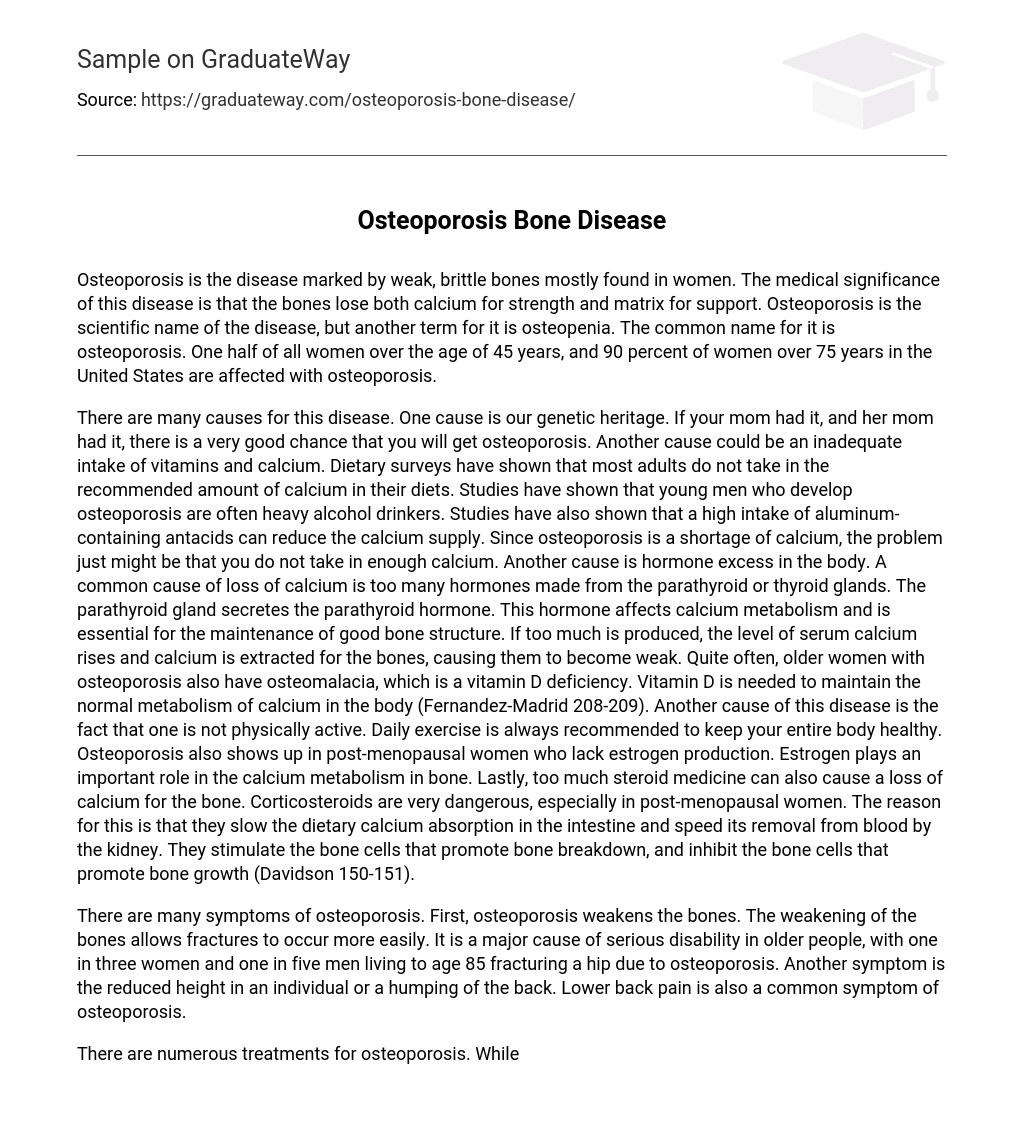Osteoporosis is the disease marked by weak, brittle bones mostly found in women. The medical significance of this disease is that the bones lose both calcium for strength and matrix for support. Osteoporosis is the scientific name of the disease, but another term for it is osteopenia. The common name for it is osteoporosis. One half of all women over the age of 45 years, and 90 percent of women over 75 years in the United States are affected with osteoporosis.
There are many causes for this disease. One cause is our genetic heritage. If your mom had it, and her mom had it, there is a very good chance that you will get osteoporosis. Another cause could be an inadequate intake of vitamins and calcium. Dietary surveys have shown that most adults do not take in the recommended amount of calcium in their diets. Studies have shown that young men who develop osteoporosis are often heavy alcohol drinkers. Studies have also shown that a high intake of aluminum-containing antacids can reduce the calcium supply. Since osteoporosis is a shortage of calcium, the problem just might be that you do not take in enough calcium. Another cause is hormone excess in the body. A common cause of loss of calcium is too many hormones made from the parathyroid or thyroid glands. The parathyroid gland secretes the parathyroid hormone. This hormone affects calcium metabolism and is essential for the maintenance of good bone structure. If too much is produced, the level of serum calcium rises and calcium is extracted for the bones, causing them to become weak. Quite often, older women with osteoporosis also have osteomalacia, which is a vitamin D deficiency. Vitamin D is needed to maintain the normal metabolism of calcium in the body (Fernandez-Madrid 208-209). Another cause of this disease is the fact that one is not physically active. Daily exercise is always recommended to keep your entire body healthy. Osteoporosis also shows up in post-menopausal women who lack estrogen production. Estrogen plays an important role in the calcium metabolism in bone. Lastly, too much steroid medicine can also cause a loss of calcium for the bone. Corticosteroids are very dangerous, especially in post-menopausal women. The reason for this is that they slow the dietary calcium absorption in the intestine and speed its removal from blood by the kidney. They stimulate the bone cells that promote bone breakdown, and inhibit the bone cells that promote bone growth (Davidson 150-151).
There are many symptoms of osteoporosis. First, osteoporosis weakens the bones. The weakening of the bones allows fractures to occur more easily. It is a major cause of serious disability in older people, with one in three women and one in five men living to age 85 fracturing a hip due to osteoporosis. Another symptom is the reduced height in an individual or a humping of the back. Lower back pain is also a common symptom of osteoporosis.
There are numerous treatments for osteoporosis. While there are ways to prevent it and to treat it, there is no cure as of yet. The main treatment is prevention, exercise, healthy living, and estrogen treatment for women are the keys to success. A big part of treatment and prevention is exercise. Muscle mass and bone formation increase with exercise, even in older people. It especially helps to exercise against gravity, such as walking a mile or more daily or at least several times weekly. An organized workout program with an exercise trainer will help you achieve the most benefit to your body within your limitations. Water exercises are also a good way to exercise. A healthy diet is also important. Getting the proper amounts of calcium and vitamin D is essential in the treatment of this disease. Vitamin D can be obtained from the sun, so walking outdoors takes care of that. Calcium may be obtained from foods or from vitamins. It is recommended that 1.0 to 1.5 grams of calcium should be taken in each day. As far as estrogen treatment goes, women who have estrogen treatment increase the calcium in their bones by seven percent versus those who do not use the treatment. The percentage of those with fractures is even lower. So far, the best know way to treat osteoporosis, is through salmon calcitonin. It is an injectable substance. It is believed that calcitonin is what regulates osteoclasts from breaking down too much bone.
Right here is where I should talk about the history of the disease. I should say who discovered it and when they discovered it, but I am not able to do that. Through all of my research, I could not find any of that information anywhere.





